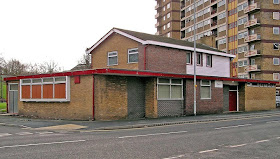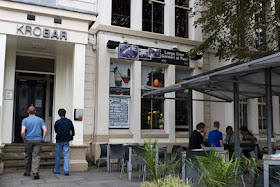Bull's Head, Greengate, Salford. (c) Sarah Welsh.
The Bull's Head on Greengate is one of Salford's better known old, lost pubs. Situated on Greengate, a few doors down from the old original Three Legs of Man (see left of second photo at link) and next door to the Old Shears at Salford Cross, the Bull's Head was a timber and plaster pub with four gables to the street. There's an 1887 photo of the Bull's Head and old Salford Cross at the Trafford council archives, and one here which claims to be from 1950 but clearly isn't.
Bull's Head, Greengate, Salford. (c) grabstarter at ebid.
"It has suffered a good deal from restoration and alterations, however, and the roofs are now covered with modern slates. The south gable is built on crucks, an interesting survival in a wilderness of brick and mortar. The house, once the abode of the Allens, has lost the projecting porch and gable, which formerly gave it an air of distinction, and has fallen on evil days [1]."
Bull's Head, Greengate, Salford. (c) ernieatqrstuv at ebay.
The Bull's Head appears on the front cover of Neil Richardson's first book on Salford Pubs [2]. Here the pub is pictured in 1878 and the licensee's name, Henry Nelson ("licensed dealer of foreign and British wines, spirits, ales and porters"), appears larger than the Bull's Head one. The building is thought to date from 1590 and lasted as a pub until 1930 as Groves & Whitnall house and was demolished in about 1938 [2].
Bull's Head, Greengate, Salford, 1878. (c) Neil Richardson [2].
2. Salford Pubs - Part One: the Old Town including Chapel Street, Greengate and the Adelphi, Neil Richardson (2003).














































